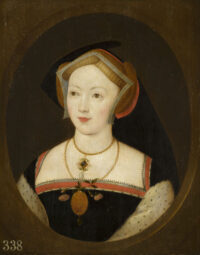 A painting in the Royal Collection previously known only as Portrait of a Woman has been identified as a portrait of Mary Boleyn, older sister of Anne Boleyn and mistress of her future husband Henry VIII. The identification was made thanks to researchers with the Jordaens Van Dyck Panel Paintings Project (JVDPPP), a multidisciplinary study based in the Royal Museums of Fine Arts in Brussels of oak panel paintings by 17th century masters Jacques Jordaens and Sir Anthony Van Dyck. The portrait is in the style of Flemish artist Remigius van Leemput, so not one of the two artists on the project’s masthead, but Leemput worked in Van Dyck’s studio and he specialized in making copies of the master’s paintings, especially his portraits of the British aristocracy. Not all of the originals have survived, so van Leemput’s work is of particular interest to the researchers both for comparative purposes and to get as close to lost originals as possible.
A painting in the Royal Collection previously known only as Portrait of a Woman has been identified as a portrait of Mary Boleyn, older sister of Anne Boleyn and mistress of her future husband Henry VIII. The identification was made thanks to researchers with the Jordaens Van Dyck Panel Paintings Project (JVDPPP), a multidisciplinary study based in the Royal Museums of Fine Arts in Brussels of oak panel paintings by 17th century masters Jacques Jordaens and Sir Anthony Van Dyck. The portrait is in the style of Flemish artist Remigius van Leemput, so not one of the two artists on the project’s masthead, but Leemput worked in Van Dyck’s studio and he specialized in making copies of the master’s paintings, especially his portraits of the British aristocracy. Not all of the originals have survived, so van Leemput’s work is of particular interest to the researchers both for comparative purposes and to get as close to lost originals as possible.
The JVDPPP examined it and another 13 portraits of women, collectively known as the Beauties, by van Leemput that are in the Royal Collection. The other 13 are contemporary portraits, however, aristocratic 17th century women garbed and coiffed in styles of their time. The unnamed woman in Portrait of a Woman is the only one in 16th century clothing and hairstyle.
They examined it in September of 2019. Dendrochronological analysis on the oak support found that it was cut from the same Baltic tree around 1629 as the only other portrait of the 14 whose sitter was previously unknown. Archival research revealed a key clue tying the two portraits together: photographs of two paintings in private collections with inscriptions identifying the 16th century woman as Mary Boleyn and the 17th century one as Lady Herbert, ie, Margaret Smith, wife of Thomas Carey who was Mary Boleyn’s great-grandson. A few years after her portrait was painted, her husband died and she married Sir Edward Herbert.
Sir Oliver Millar, then Surveyor of H. M. The Queen’s Pictures, wrote in his 1963 book The Tudor, Stuart and Early Georgian Pictures in the collection of Her Majesty the Queen that in the 19th century the painting was believed to be one of several copies of a Hans Holbein portrait of Anne Boleyn. By 1861 it was listed in the catalogue as a “portrait of a lady” and the sitter has been anonymous for nearly 160 years until this discovery.
Desmond Shawe-Taylor, Surveyor of the Queen’s Pictures, told the Sunday Telegraph: “It’s absolutely fascinating. We don’t have the resources to apply technical examination like dendrochronology to the whole collection, which is 7,000 paintings, so it’s wonderful to collaborate with the JVDPPP to help us in that way. One of the things that I’m endlessly trying to do is to group the paintings properly to sort out their history and their relationship to each other.
“When a stray is reunited with the family, there’s joy in heaven. It disproportionately increases the value and understanding of the whole group.”
Describing the paintings as “absolutely beautiful”, he said that the set could now be reunited.
Justin Davies, a British art historian and JVDPPP co-founder, said of the research: “It’s been a voyage of discovery. The results were remarkable and unexpected. Six of the 14 panels had been made from the same oak tree. The tree had started growing in south-west Germany before 1393 and was cut down between 1651 and 1671. In itself, this result constitutes a world record – six panel paintings from the same tree had not been recorded before.”
He added: “The remaining eight pictures are four pairs of two in terms of their trees of origin. “
The newly-identified Mary Boleyn portrait now hangs in the bedchamber of Mary, Queen of Scots, at the Palace of Holyroodhouse in Edinburgh.